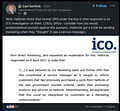The DPOInsider covers the latest news and developments in data compliance and privacy. The DPO's favourite weekly read ☕️
Cost of a data breach
How much does a data breach cost?
Of course, this isn’t the easiest thing to define. But as more and more organizations fall victim to attacks, it’s a question that more and more businesses are trying to answer.
According to IBM's latest cost of data breach report, in 2022, the average cost of a data breach globally reached an all-time high of $4.35 million. This figure represents a 2.6% increase from the previous year and a 12.7% rise from 2020.
Factors such as incident type and severity, regulatory standards, company size, sector, and region can significantly affect how much a data breach could cost a business. Still, all organizations must carefully assess and prepare for the monetary hits that could be just around the corner should they fall victim. Some are potentially far more damaging (and less obvious) than others.
Also, businesses need to consider not just the monetary value.
It’s an old cliché, but you can’t put a dollar on customer trust, and a damaged reputation remains one of the most significant data breach costs for organizations in 2022.
No matter the specific costs involved, experts agree that, ultimately, preparedness is key to managing the monetary repercussions of a data breach. “Faster incident response continues to be a clear driver for lowering the cost of a breach,” Dutile says. “The worst losses are those that go undetected for an extended time or have a slow or ineffective response.”
What marketers need to know about the changing landscape of data privacy
As mentioned in a previous edition, we will look at what the changing data privacy regulations mean for marketers.
I have taken a lot of inspiration here from a great podcast from The Search Laboratory, which you can listen to here.
With the decline of third-party cookies and the increasing number of changes across technology, government regulation and consumer privacy awareness, it’s becoming increasingly difficult for marketers to measure conversions and
The number of gaps in user journeys is rising, and with the need for explicit consent for placing cookies, as well as ITP and Safari’s privacy initiative now removing first-party cookies after seven days, marketers are forced to find new ways to track conversions and attribute value to each touchpoint.
GA4
One of the most significant changes in the privacy landscape has been the arrival of Google Analytics 4 (GA4). Along with the many changes in regulation and technology, the way we browse the internet has also evolved significantly, changing how we track users in analytics.
Changing cookie policies
Methods of implementing new cookie policies vary wildly across countries and regions. Given the huge amount of data that is lost with the departure of cookies, many businesses are designing a simple option to accept all cookies and a much more difficult route to decline or amend cookies.
In the US, there are movements toward a federal data privacy law to cover the entire country, similar to Europe’s GDPR, which would overwrite the current state-level privacy laws. In June, the senate proposed a bill called The American Data Privacy and Protection Act. This would allow users to opt-out of targeted advertisements and sue companies that sell their data.



